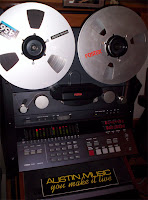An analog recording is one where the original sound signal is modulated onto another physical media or substrate such as the groove of a gramophone disc or the iron oxide surface of a magnetic tape. A physical quality in the medium (e.g., the intensity of the magnetic field or the path of a record groove) is directly related, or analogous, to the physical properties of the original sound (e.g., the amplitude, phase, etc.)
A digital recording is produced by converting the physical properties of the original sound into digital information (called bits), which can then be stored and played back for reproduction. The accuracy of the conversion process depends on the sampling rate (how often the sound is sampled) and the sampling depth (how much information each sample contains). However, unlike analog recording, the physical medium for storing digital samples becomes immaterial in recovery of the encoded information as long as the individual bits can be recovered.
digital information (called bits), which can then be stored and played back for reproduction. The accuracy of the conversion process depends on the sampling rate (how often the sound is sampled) and the sampling depth (how much information each sample contains). However, unlike analog recording, the physical medium for storing digital samples becomes immaterial in recovery of the encoded information as long as the individual bits can be recovered.
Accurate, high quality sound reproduction is possible with both analog and digital systems. The principal advantage that digital systems have over analog systems is lower costs for end users. With analog recordings, consumers must use high-quality playback equipment to accurately separate the signal from the background without picking up noise or distortion. With digital, only the signal is encoded, so playback equipment can be much less expensive for a given quality. (Incidentally this same principle applies to digital video and still photography.)
found at: http://en.wikipedia.org/wiki/Analog_sound_vs._digital_sound



